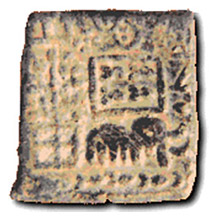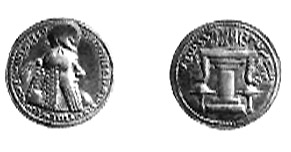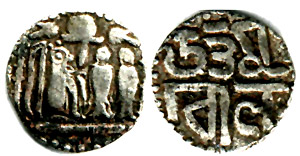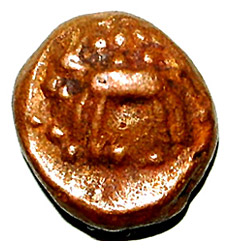 Some of the earliest coins found in Tamil Nadu belong to the dynasty of the Cheras of the Sangam age (2nd century B.C. to 3rd century A.D.), who like their contemporaries, the Sangam Cholas and the Sangam Pandyas, issued a large number of coins.
Some of the earliest coins found in Tamil Nadu belong to the dynasty of the Cheras of the Sangam age (2nd century B.C. to 3rd century A.D.), who like their contemporaries, the Sangam Cholas and the Sangam Pandyas, issued a large number of coins.
Thousands of Chera coins have been found near Karur (Tamil Nadu), their ancient capital city especially on the banks of the river Amaravati. A few coins have been reported from Parur and some other places in Kerala. Recently, a single Sangam Chera coin was found at the newly discovered site Pattanam on the south bank of the Periyar River in Kerala. A single specimen of their coin has been reported from Kantarodai in north Sri Lanka also.
The Sangam Chera coins are of mainly made of copper while a few specimens are of base silver and very rarely of lead. The copper coins are circular, rectangular or square in shape, the lead coins are rectangular or square and the silver ones are invariably circular. Recently an attractive oval-shape copper coin has also come to light. Most of these coins were produced using the punch-marked technique. The most common motif appearing on the obverse of these coins is the elephant while others also feature the horse, bull or lion, A few rare Chera coins portray the royal bust. The reverse of the coins mostly portray the bow and arrow, the dynastic crest of the Cheras.
Coins of the Sangam Cholas
Coins of the Cholas have been found at Karur, Tirukoilur and unearthed during archaeological excavations at the coastal sites of Kaveripumpattinam (Pumpuhar) and Arikamedu (near Pondicherry). A few have also been found in Sri Lanka and an interesting coin of this dynasty has been reported in the stratified context from the distant site of Khuan Luk Pat on the west coast of Thailand. Most of the Sangam Chola coins are made of copper and a few are of lead. The majority is die-struck but a few specimens have been manufactured by the process of punching. One rectangular copper Sangam Chola coin exhibits both these minting processes the face has been die-struck following which the reverse motif has been punched. The obverse of the Sangam Chola coins usually features the elephant and sometimes the bull, horse or the tree-in-railing. The repeated depiction of the Sun symbol reveals that the Cholas belonged to the Solar race (Surya-vamsa). The reverse of their coins normally features the tiger as it was the royal crest of this dynasty.
Coins of the Sangam Pandyas
 The Pandyas coins have been discovered at Madurai and other places in the Pandyan region and also in Anuradhapura in Sri Lanka. The coins of this dynasty are mostly in copper and sometimes in sliver. They are usually die-struck but some are punch-marked, The motifs appearing on the obverse of the Pandyan coins are the elephant, horse, bull, tortoise, fish, Sivalinga, svastika, domed temple, etc. Some of these coins bear legends on the reverse in the Tamil language and Tamil Brahmi script which convey the name or the title of the ruler. The reverse of most of their coins portrays the fish which was their dynastic emblem.
The Pandyas coins have been discovered at Madurai and other places in the Pandyan region and also in Anuradhapura in Sri Lanka. The coins of this dynasty are mostly in copper and sometimes in sliver. They are usually die-struck but some are punch-marked, The motifs appearing on the obverse of the Pandyan coins are the elephant, horse, bull, tortoise, fish, Sivalinga, svastika, domed temple, etc. Some of these coins bear legends on the reverse in the Tamil language and Tamil Brahmi script which convey the name or the title of the ruler. The reverse of most of their coins portrays the fish which was their dynastic emblem.
Coins of the Malaiyaman chieftains
All their coins are of copper and die-struck on thick copper sheets, hammered and cut to the requisite shape. The main motif on the obverse of most of their coins is the horse standing with a stool or a pillar in front of it and a vessel or basin placed on the stool or pillar. Coming to the reasons for the prominence accorded to the horse on Malaiyaman coins, Sangam literature indicates that Tirumudi Kari, the greatest
Malaiyaman ruler was an excellent horseman. He maintained many high-quality horses in his palace and named his favourite horse `Kari`. Probably, he minted the first Malaiyaman coins or the first horse-type Malaiyaman coins and his successors may have continued this motif on their coins. Usually the reverse of most of the coins of this dynasty feature hillocks, rivers and roads in varied angles and positions. Usually, three and sometimes two hills are represented in a row.
Coins of the Kalabhras
A small number of coins attributed to this dynasty have recently come to light, found in and around Madurai. One of the Kalabhra coins is a small, square specimen, each side measuring 2 cm. made of copper and weighs 7.45 grams. The obverse portrays a big tusker with its trunk hanging downwards and terminating in an inward twist. Above the elephant is a legend in Tamil language and Tamil-Brahmi script, written in anti-clockwise direction. It reads Kalapira.
Coins of the Pallavas
 Their coins are mostly of copper. A few of their coins are of silver or electrum, an alloy of gold and silver, and some are also made of lead. Archaeologists have unearthed Pallava lead coins from Kanchipuram. The obverse of the Pallava coins usually has the figure of the lion or the bull. The bull was the dynastic crest of the Pallavas. The reverse of the Pallava coins display many types of symbols and objects such as tree, lotus, wheel, lamp, boat or ship, dagger, svastika, etc. One rare coin features the tiger, fish and bow. Since the tiger was the emblem of the Cholas, the fish of the Pandyas and the bow of the Cheras, some scholars feel that this particular Pallava coin was issued to commemorate the extension of Pallava power to Chola, Pandya and Chera territories.
Their coins are mostly of copper. A few of their coins are of silver or electrum, an alloy of gold and silver, and some are also made of lead. Archaeologists have unearthed Pallava lead coins from Kanchipuram. The obverse of the Pallava coins usually has the figure of the lion or the bull. The bull was the dynastic crest of the Pallavas. The reverse of the Pallava coins display many types of symbols and objects such as tree, lotus, wheel, lamp, boat or ship, dagger, svastika, etc. One rare coin features the tiger, fish and bow. Since the tiger was the emblem of the Cholas, the fish of the Pandyas and the bow of the Cheras, some scholars feel that this particular Pallava coin was issued to commemorate the extension of Pallava power to Chola, Pandya and Chera territories.
Coins of the Pandyas
One of their interesting coins is made of gold and has two fish, the dynastic crest of the Pandyas, on one side and the legend Sri Varaguna in Grantha characters on the other. Another important coin of the early Pandyas is made of copper and has the symbol of two fish on the obverse and on the reverse the legend Sri Avanipasekbaran KolakaThe 13th century A.D. saw the Pandyan empire at its height and a number of coins of the Pandyas bearing their names may be assigned to this century. There are several varieties of coins bearing the legend Sundam Pandya, of varying shapes and sizes. They were probably issued by different rulers having the same name.
Coins of the Imperial Cholas
The Cholas of Tanjavur issued coins in gold, silver and copper. While some of the gold coins are very pure, the others are often alloyed with silver. In fact, a number of gold coins are actually of silver plated with gold Likewise, a few of the Chola silver coins are actually copper coins coated with silver. The Cholas issued coins thick as leather and as thin as tracing paper. All the coins are circular in shape. The coins depict interesting symbols. Many of them feature the tiger along with the fish and bow. Thousands of dark, tiny, worn and bent Chola copper coins have been discovered all over Tamil Nadu. These coins appear like tamarind seeds. In many villages, children play with these coins even today.
Coins of the Nayakas
Sevappa, the first Nayaka king of Tanjavur issued a coin featuring a conch. His grandson, Raghunatha Nayaka minted coins depicting Lord Rama, Lakshmana, Sita and Hanuman - all in standing pose. A very rare copper coin of this ruler displays, on its obverse the standing figure of God Kartikeya or Muruga with his favourite peacock behind him. The reverse of this coin depicts the Nandi (sacred bull) of Lord Siva below the Sivalinga.
 The Madurai Nayaks issued many coins featuring the fish - the emblem of the Pandyas who ruled Madurai before the Vijayanagara and Nayak rulers. Some of the earliest Madurai Nayak coins portray the figure of the king. The bull is also frequently seen on their coins.
The Madurai Nayaks issued many coins featuring the fish - the emblem of the Pandyas who ruled Madurai before the Vijayanagara and Nayak rulers. Some of the earliest Madurai Nayak coins portray the figure of the king. The bull is also frequently seen on their coins.
Coins of the Marathas of Tanjavur
The Marathas kings who ruled Tanjavur after the Nayakas, were ardent devotees of Lord Siva or Chandramoulisvara, their family deity and issued coins portraying this deity. They also issued a copper coin featuring a four-armed Goddess seated cross-legged. The reverse of this coin bears the legend Maharaj in Nagari script.
Coins of the Nawabs of Arcot
The Nawabs of Arcot, issued many coins in copper and a few in gold and silver. The earliest coins of the Arcot Nawabs were issued in the name of the Mughal emperor and later the Nawabs began to issue coins in their own name. Most of their coins bear inscriptions in Persian while a few coins have inscriptions in Tamil. Various motifs such as the flower, horse, elephant, fish, flag, sun, moon, dagger, peacock and geometric designs have been featured on their coins. Although the Arcot Nawabs were Muslims, they often portrayed several Hindu deities and symbols such as the Siva Linga and Nandi on their coins, mainly to please their Hindu subjects.
Coins of the Tondaimans of Pudukkottai
A very large number of kingdoms, both big and small, existed when the British ruled India from around 1757 to 1947. Among these were the Tondaiman rulers of Pudukkottai who are famous for a unique circular copper coin they minted called Amman Kasu. The obverse of this coin portrays Goddess Parvati or Brihadamba, seated wearing a short skirt. The reverse of the Amman Kasu bears the legend Sri Vijuya (victory) in Telugu. Goddess Brihadamba is the presiding Goddess in the historic Siva temple at Tirugokarnam in Pudukkottai. The royal family worshipped in this temple which was also the venue of the coronation of many of the Tondaiman rulers. The first Amman kasu was minted in the year 1738. During the Navaratri festival, the Tondaiman king gave the Amman kasu along with a bag of rice and other gifts to all those who visited his palace.` Of all the coins issued by the various native states, the Amman kasu is well-known and is even worshipped in many Hindu households.






































